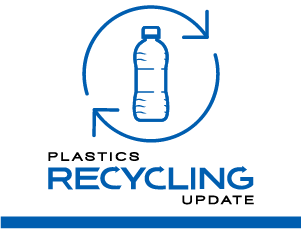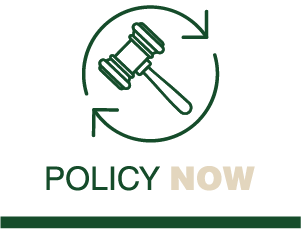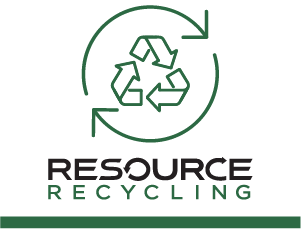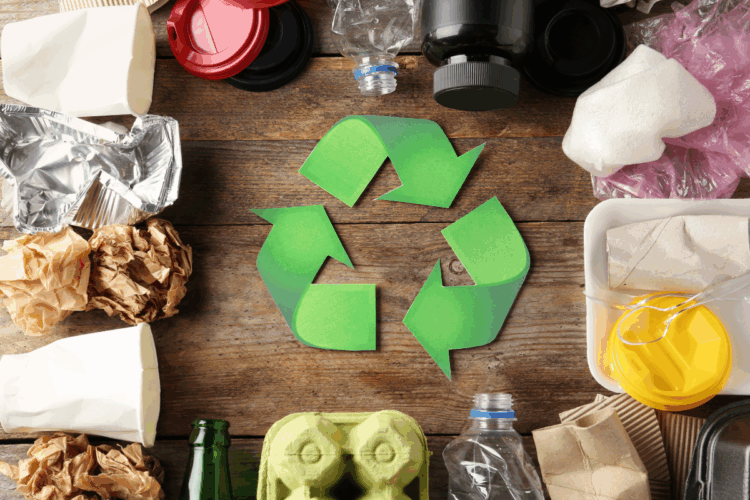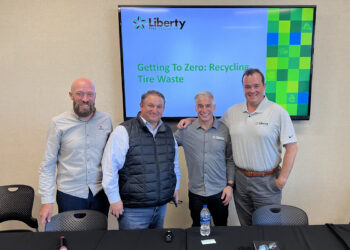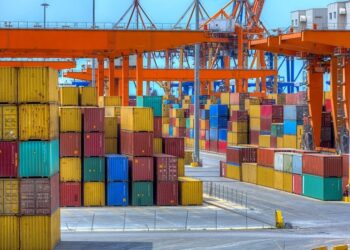Backed by major brands, The Recycling Partnership has become well-known in the materials recovery sector over the past decade for boosting access to recycling, in particular by helping municipalities roll out recycling carts, improve outreach and reduce contamination.
CEO Keefe Harrison founded the organization in 2014, wanting to move a step beyond what she saw as the “name and shame” nonprofits that call out companies for failure to take action.
“I wondered, ‘What then?’ Like, once they’ve been named and shamed, what happens? And so, we really built The Recycling Partnership around an ‘insist and assist’ model,” Harrison told Resource Recycling. “That is core to everything we do. We want to insist that companies meet goals, and we do that by holding them accountable, but we also do that by assisting, by helping.”
These days, with extended producer responsibility (EPR) set to roll out in seven U.S. states in the next several years, Harrison is looking with concern at recycled material end markets, which she says need to receive equal attention. She’s also vocal about the essential role policy plays, and how recent years have shown the limit of where voluntary action can take the industry.
Resource Recycling spoke with Harrison about end markets, brand owners rolling back recycled content targets, and the detrimental effects of “silver bullet” thinking when trying to improve the U.S. recycling system.
This conversation has been edited for clarity and brevity.
Many brands set voluntary recycling-related pledges over the past seven or eight years, many with a target date of 2025. As 2025 approached, a lot of the brands announced problems meeting these goals, and in some cases, reported backsliding on recycled content use. Why are companies struggling to meet their sustainability and recycling-specific goals?

We see rollbacks this year from investment firms, CPGs, retailers, and at our board meeting last week, we talked about what that really means for the system as a whole. And I think that we could be on the verge of something very serious here, if we don’t see the increased use of recycled content. So that’s what I brought to our board last week, and they agreed — and these are some of the same companies that are rolling back their commitments — that we need to be doing more to talk about what happens if EPR is pumping supply into the system, but we don’t have demand components that are pulling it back out of the system.
And so, what kind of commitments are getting rolled back? I see everything from design commitments, recycling and compost and reuse commitments, reduction commitments are even getting rolled back, and we see an increased production of plastic anticipated. And I am particularly concerned about rollbacks in the use of recycled content.
I think that there’s a real accountability lack or gap across the board, and that comes from changes at the federal government, that comes from concerns about the economy that become opportune times to roll back commitments. But I also see kind of a balance of some companies that are maybe softening their words, but not quite softening their activities, and it’s a way to weather the times. But overall, I’m very nervous.
Has the level of pressure on companies changed since some of these commitments were made? At the federal government, regardless of whether there were policies in place, the culture has changed. The corporate culture has changed quite a bit. Does that mean there is a renewed place for the ‘name and shame’ approach?
There might be.
I think at the federal government there is a rollback on pressure, but that isn’t letting up from the consumer view. And that isn’t letting up from the state perspective. In the plastics world, the INC-5.2 will take place in August, and everyone’s looking to see if it will have teeth, right?
I would caution brands and companies from thinking that it’s just a free landscape, because the public hasn’t changed their tune. They’re ticked, and they’re concerned about pollution and they’re concerned about the climate. So maybe it’s better to say that the pressurers are changing.
Let’s talk about recycled content — what I hear from brands is, ‘we can’t find the material.’ And then I write that, and then I hear from reclaimers saying, ‘you forgot to add the next part: we can’t find the right material at the price we want.’ Is there truth to both of those statements?
It’s all about the price part.
A lot of companies will say that this is out of their control. They want it to happen, but a lot of these things are the disconnect between what we want and the reality of what is truthful. It creates a lot of space for wishful thinking, and I think it’s The Partnership’s job to lean into that, to say, “hold the phone — if we really want a recycling system that works, companies need to buy recycled content and put it to work in their products.”
I think we can peel this back into three things.
One, I think there’s often goals without a clear-eyed example of what it will really take to get there. So for example, in California, we did a big gap analysis of, if film and flexible packaging is going to be recyclable at a 65% recycling rate, we need to look at five parts of the healthy system: product design, can communities accept it, does the public do it, can a MRF sort it and does an end market make sure that old stuff turns to new stuff.
For each of those, you can do a gap analysis with a cost of what it will take to fix it, and a timeline and order of operations. And when we show that sometimes to companies, they’re like, “that’s too big, we can’t do that,” but that is the truth of what system change costs. So I think number one is really about the clear-eyed gap analysis, because what we’re seeing is — number two — a jump to cheap silver bullets.
When people get a little freaked out about what system change really looks like, they sometimes say, “I want to just do this one part.” And that really hurts me, because when we see an over index of silver bullets that we know are not going to work, the flip side of that is then companies say, “Well, we tried, but it’s just not fixable.” Well, it’s like if you’re trying to build a house, but you only build the south-facing wall. The building is not going to keep out the rain, right? So we have to look at the whole system, and then the only way I know to look at the system is the third part, and that’s policy.
So, I’m thrilled that 20% of the U.S. population are now covered by EPR policy. But for the most part, EPR is about how you get material in. Now we need more policy that’s really about making sure that it’s designed for the system and that there’s offtake and end-market agreements in there.
Looking back at how exactly corporate commitments are changing, in some cases goals have been abandoned altogether, but on recycled content what I’ve seen is they’re maybe lowering the percentage target, and then also pushing the target date out. Should we feel more confident about companies meeting these goals in another five years?
Will companies meet goals just because they stretch that out by five years? Not unless they get serious about what problem they are really trying to solve. So I come back to, what are the five parts of the healthy system and what’s the gap?
I am super proud of everything that The Partnership has built in our decade-plus of existing. We have worked our tails off to generate half a billion dollars’ worth of impact. That’s our corporate commitment. That’s our match from local governments. That’s work that we did to help communities get ready for EPA grants. That is critical, and I couldn’t be more proud of growing from an idea to that in about 10 years. However, we’re trying to solve a problem that has a $17 billion capex to fix the U.S. system and an annual operating budget of about the same — $17 billion. So while I’m so proud of what we have done thus far at The Partnership, the gap between that and what the real long-term solution is remains.
I intend to use The Partnership’s success and opportunity to continue to grow, to show what is the limit of what voluntary could do alone. That’s what we’ve been this far, right, “Commit to us and help us make change.” That’s a voluntary action. I think we’re at the ceiling of what we could see for a voluntary action, and without a policy driver, we’ll never get to that $17 billion. I can plead for companies to use recycled content, and they can respond, “I’d love to, but it’s more expensive.”
So the question is, how do we level the playing field, and the answer lands in policy levers.
We often hear EPR talked about as if it’s going to fix everything, and it really seems to be the basket that a lot of the policy eggs are in currently. There doesn’t seem to be as much discussion about recycled content mandates. Do you think EPR is looked at as one of those silver bullets?
So we’re using bullets, and we’re using eggs in a basket, we’re using a lot of analogies, but I like your egg analogy. And here, we’re trying to make a multi-egg omelet or frittata.
EPR is critical, we cannot make this whole system work without producer responsibility, so I think EPR is not a silver bullet, but it’s part of a really healthy portfolio, and so I’d like to see it tied together with more. The EPR laws in Colorado and Minnesota have PCR requirements, for example, but not all of them do.
Without a policy lever there, it’s just going to follow the cheapest option — if recycled content is always fighting against an influx of cheap virgin, it’s at a loss. And without regulation about domestic or North American supply of recycled content, we’re also fighting a tricky battle because the estimates I’ve seen recently around the import of recycled PET — or what claims to be recycled PET — are that imports have more than doubled in the last year. So the estimates that I’ve seen is that’s an increase of more than 500 million pounds of material, and that trend is continuing. Is it recycled content? Who knows. Is that helping the U.S. recycling system? No. Is that helping the success of EPR? No. So that’s a worrying trend that I think we need policy to help address.
What happens if EPR comes online and there’s no similar expansion of end markets?
That’s the question I think we should all be asking. And I’d like to see brands and retailers really doubling down on their commitments to make sure that they’re putting this material to work.
You know, I think we can look to other examples from policy initiatives. I look at 15- or 20-year-old EPR laws around electronics. Part of the reason they were in place was to get cathode ray tubes, old TVs, out of the system. And the concern was really about leaded glass. But without markets for putting that leaded glass into use, you saw those fees get them back, but then you saw the materials sit around. And eventually, the fees were gone, but the material was still there. So that’s a lesson we should make sure we’re not repeating.
So what is The Partnership going to do about that? We’re going to dig into what some of the policy solutions could and should be for the U.S. when it comes to recycled content end markets. Is that a credit approach of using recycled content? Or is it a plug-in to EPR or a standalone bill? Or is it a tax credit for the purchase? We’re doing some analysis right now, but we’re not going to sit idle and just wring our hands about this. We’re going to beat the drum that we’ve got to make sure recycled content gets used. We’re going to look for voluntary engagement around that. But I think this has to be a policy play as well.
As EPR programs come online in the next few years and producer funding enters the system in a larger way, can you paint a picture of the U.S. recycling industry you see five years from now?
Well, if we don’t fix demand, if we don’t fix end markets and use of recycled content, I’m going to paint an ugly picture. I’m going to paint a picture of oversupply, of compliance teams and corporations who are frustrated, of state-level policymakers who are angry. I am going to paint a picture of a challenged planet that’s over-tapped on resources. I don’t like that picture at all, and so that’s why I want to raise the concern right now about the importance of end markets.
And that means I’m going to keep having conversations with individual companies. I’m going to have conversations like you and I are having now. I’m going to launch a task force to evaluate the best policy mechanisms, and I’m also, importantly, going to challenge companies to stay really focused on how big this challenge and thus this opportunity is, and to look for partners who are constantly learning. Because we will need to try things and fail fast, and share learnings with competitors, with other organizations, with this whole network of recyclers.
If we’re really going to deploy this awesome moment we have of EPR coming online, we’re going to have to learn quickly and fail fast.



